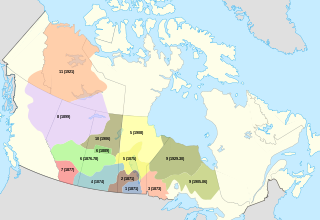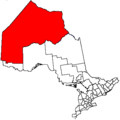
The Cree are a North American Indigenous people. They live primarily in Canada, where they form one of the country's largest First Nations.
First Nations in Ontario constitute many nations. Common First Nations ethnicities in the province include the Anishinaabe, Haudenosaunee, and the Cree. In southern portions of this province, there are reserves of the Mohawk, Cayuga, Onondaga, Oneida, Seneca and Tuscarora.
Neskantaga First Nation is a remote Oji-Cree First Nation band government in the northern reaches of the Canadian province of Ontario, situated along the shore of Attawapiskat Lake in the District of Kenora.

The Attawapiskat First Nation is an isolated First Nation located in Kenora District in northern Ontario, Canada, at the mouth of the Attawapiskat River on James Bay. The traditional territory of the Attawapiskat First Nation extends beyond their reserve up the coast to Hudson Bay and hundreds of kilometres inland along river tributaries. The community is connected to other towns along the shore of James Bay by the seasonal ice road/winter road constructed each December, linking it to the towns of Kashechewan First Nation, Fort Albany, and Moosonee Attawapiskat, Fort Albany, and Kashechewan operate and manage the James Bay Winter Road through the jointly owned Kimesskanemenow Corporation, named after the Cree word for "our road" -kimesskanemenow. Attawapiskat is the most remote northerly link on the 310 km (190 mi) road to Moosonee. They control the reserves at Attawapiskat 91 and Attawapiskat 91A.

The Numbered Treaties are a series of eleven treaties signed between the First Nations, one of three groups of Indigenous Peoples in Canada, and the reigning monarch of Canada from 1871 to 1921. These agreements were created to allow the Government of Canada to pursue settlement and resource extraction in the affected regions, which include modern-day Alberta, British Columbia, Manitoba, Ontario, Saskatchewan, and the Northwest Territories. These treaties expanded the Dominion of Canada with large tracts of land in exchange for promises made to the indigenous people of the area. These terms were dependent on individual negotiations and so specific terms differed with each treaty.

The Kashechewan First Nation is a Cree First Nation band government located near James Bay in Northern Ontario, Canada. The community is located on the northern shore of the Albany River. Kashechewan First Nation is one of two communities that were established from Old Fort Albany in the 1950s. The other community is Fort Albany First Nation, which is now located on the southern bank of the Albany River. The community is connected to other towns along the shore of James Bay by the seasonal ice road/winter road, linking it to the towns of Attawapiskat, Fort Albany, and Moosonee.
Attawapiskat Airport is an airport adjacent to the Attawapiskat First Nation in Ontario, Canada.

Thunder Airlines is a Canadian scheduled flight, charter and medevac airline based in Thunder Bay, Ontario. It offers an on-demand charter service from bases in Thunder Bay and Timmins. The company was founded in 1994 and operates fourteen aircraft and flies to six destinations regularly.
Attawapiskat may refer to:

Attawapiskat 91A is the main reserve of the Attawapiskat First Nation, near the mouth of the Attawapiskat River in Kenora District, Ontario, Canada.
Attawapiskat Lake is a lake in Kenora District, Ontario, Canada. The primary inflows are the Otoskwin River, the Marten-Drinking River and the Pineimuta River. The two outflows are the Attawapiskat River and the North Channel, which itself flows into the Attawapiskat River.
The Victor Mine was the first Canadian diamond mine located in Ontario, and De Beers' second diamond mine in Canada. It is located in the Northern Ontario Ring of Fire, in the James Bay Lowlands 90 kilometres (56 mi) west of Attawapiskat in the remote northern part of the province. In June 2005, the Attawapiskat First Nation voted in favour (85.5%) of ratifying the Impact Benefit Agreement (IBA). Construction of the mine began in February 2006 which created 3200 positions; mining and operations will create around 400 permanent positions. The Victor Mine is an open-pit mine, with a processing plant, workshops, and an airstrip located on site. By 2013–2014 royalties collected from De Beers Victor Mine amounted to $226. At that time De Beers was continuing to pay off its "$1 billion investment to build the mine and from now until it closes, the company expects to pay tens of millions of dollars in royalties." The mine completed mining and processing in 2019 and has moved to a shut-down phase including demolition of infrastructure and rehabilitation of the site.

Shannen's Dream is a Canadian youth-driven movement advocating for equitable education funding for First Nations children. Education on-reserve is funded by the Government of Canada, while off-reserve education is funded by provincial or territorial governments. Several reports by the Auditor General of Canada, the Parliamentary Budget Officer, and other authorities have indicated an urgent need for improved funding for on-reserve education. Shannen's Dream advocates for the building of safe and comfy schools on reserves, and culturally based education for all First Nations children and youth. The movement was named in honour of Shannen Koostachin, a young activist from the Attawapiskat First Nation and a nominee for the 2008 International Children's Peace Prize

Idle No More is an ongoing protest movement, founded in December 2012 by four women: three First Nations women and one non-Native ally. It is a grassroots movement among the Indigenous peoples in Canada comprising the First Nations, Métis and Inuit peoples and their non-Indigenous supporters in Canada, and to a lesser extent, internationally. It has consisted of a number of political actions worldwide, inspired in part by the liquid diet hunger strike of Attawapiskat Chief Theresa Spence and further coordinated via social media. A reaction to alleged legislative abuses of Indigenous treaty rights by then Prime Minister Stephen Harper and the Conservative federal government, the movement takes particular issue with the omnibus bill Bill C-45. The popular movement has included round dances in public places and blockades of rail lines.
Theresa Spence is a former chief of the Attawapiskat First Nation in Canada. She was a prominent figure in the Attawapiskat housing and infrastructure crisis, Idle No More, and other First Nations issues. Prior to serving as chief, she was the deputy chief of Attawapiskat.
The People of the Kattawapiskak River is a 2012 documentary film by Alanis Obomsawin exploring conditions inside the Attawapiskat First Nation, which in October 2011 declared a state of emergency due to health and safety concerns over a lack of housing and infrastructure, and remained in the public spotlight during the Idle No More protests.
Hi-Ho Mistahey! is a 2013 National Film Board of Canada feature documentary film by Alanis Obomsawin that profiles Shannen's Dream, an activist campaign first launched by Shannen Koostachin, a Cree teenager from Attawapiskat, to lobby for improved educational opportunities for First Nations youth.
The Kapiskau River is a river in the far northeast of Kenora District in Northwestern Ontario, Canada. It is a tributary of James Bay.
Midnight Shine is a Canadian roots-rock band from Northern Ontario and Manitoba, consisting of lead vocalist/guitarist Adrian Sutherland, bassist/vocalist Stan Louttit, guitarist/vocalist Zach Tomatuk and drummer Charnelle Menow. They have released three studio albums and three music videos and have been actively touring across Canada since 2016.
Otoskwin–Attawapiskat River Provincial Park is a provincial park in northern Ontario, Canada. As a waterway park, it protects the banks and waters of the Otoskwin and Attawapiskat Rivers, in Ontario's Kenora District. It provides backcountry camping and extensive whitewater canoeing opportunities.








